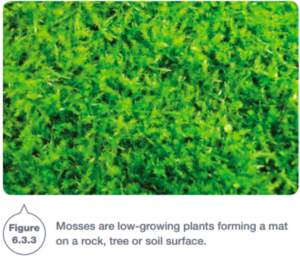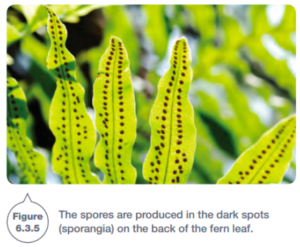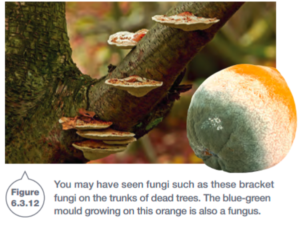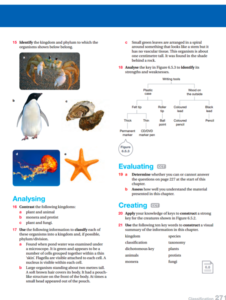You are probably familiar with plants as a group but may not know as many plant names. It is likely that you will have seen fungi in the form of mushrooms you eat and bracket fungi on trees. You are less likely to be familiar with organisms from the other two kingdoms- Monerans and Protists- because they can only be seen using a microscope.
Plant kingdom
The plant kingdom, like the animal kingdom contains a larger number of very different organisms.
Plants are classified by the way they produce and whether or not they have organized systems for transporting substances such as water through the plant.
Instead of the kingdom being subdivided into phyla as in the animal kingdom, the plant kingdom has divisions. The divisions are then divided again into classes.
Plant divisions

Mosses and liverworts
Liverworts and mosses are usually very small because they do not have any tissues to transport water or nutrients through the plant. They absorb water from the atmosphere through their leaves.
Therefore, they mostly live in damp places where they are not in danger of drying out. Mosses reproduce using single cells called spores that grow into a new moss plant.

Spores are produced in special structures known as sporangia. They grow from the top of the leafy moss plant. The spores develop in the capsule at the end of the stalk. When the spores are ripe the capsule opens and spores are blown by the wind. When the spore lands in a suitable area, the spore will grow into a new moss plant.
Ferns
Ferns have a vascular system for transporting food and water throughout the plant. They also reproduce using spores produced in structures known as sporangia.

Seed-Producing plants
Seed-producing plants reproduce using seeds. Seeds are more complex than spores. Once cell within the seed becomes the new plant. There are many other cells in the seed. These other cells provide food for the developing plant until the leaves are formed. The division of seed producing plants has four classes:
- Cycads
- Ginkgo
- Conifers
- Flowering plants
Fungi Kingdom
Mushrooms, toadstools and the bracket fungi are fungi that are big enough to be easily seen. Other fungi, such as the yeast, are so small that they can only be seen through a microscope- they are microscopic.

Fungi cannot make their own food, and therefore they must feed on other organisms. Fungi are the main cause of decay in fruit and vegetables. Fungi are decomposers responsible for breaking down wastes like faeces and dead organisms and returning the nutrients they contain to the environment.
Fungi are the source of some medicines. For example the antibiotic penicillin is prepared from penicillium, a blue-green mould. Penicillin is used to fight bacteria diseases.
Protists Kingdom
Most organisms in the protist kingdom live in water. The protists are more diverse than any other kingdom, and they are grouped together because they do not fit any other kingdom.

Monera Kingdom
The monera kingdom includes all the organisms known as bacteria. This kingdom is so diverse that some taxonomists believe it should be divided into two kingdoms or even into three major groups.
Most bacteria need to consume other organisms for their food. However, bacteria such as cyanobacteria or sulfur bacteria make their own food.
Bacteria live in many different places, ranging in temperature from hot springs, where the temperature reaches 300ºC, to the ice fields of Antartica.

A close look at kingdoms






